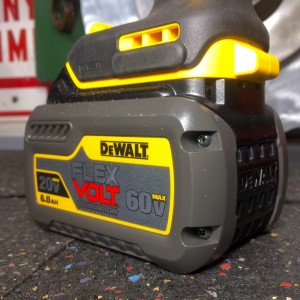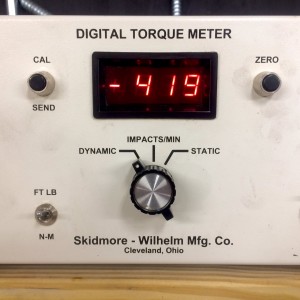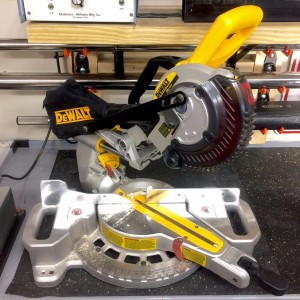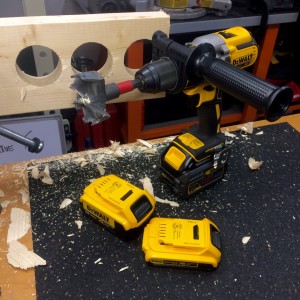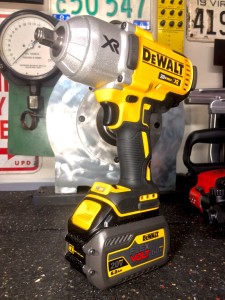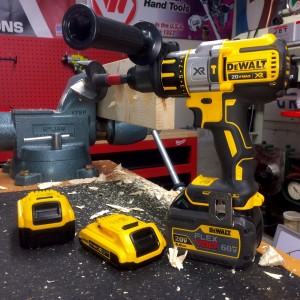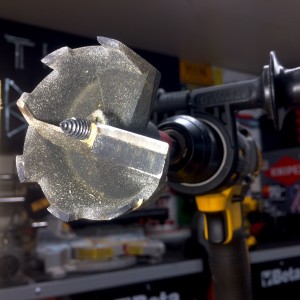The age old question — Does size matter? When it comes to battery packs, there is more to it than you might think.
With the recent release of the new Dewalt FlexVolt lineup, we decided to take an in-depth look into the actual performance that you will get out of those batteries — and more specifically, if your standard 20v tools will see any increase in power levels by using them.
Since the FlexVolt packs are dual voltage (60v & 20v), they will work on all of the new 60v tools & older 20v tools exactly the same way. This means that even though Dewalt did release a new line of cordless tools, they did not abandon the previous lineup, which is very typical with manufacturers in the past. By doing so, it means that your brand new 60v batteries/chargers will be compatible with the current 20v tools — giving you much longer run-times.
How is this possible?
Basically when you are looking at a FlexVolt battery, it has two different functions. When 60v tools are attached to it, an internal switch is activated which rewires the internal battery cell connections to link them all in series (15 cells @ 2.0ah each x 4 volts = 60 volts @ 2.0ah). Alternatively, when you install that same battery on a 20v tool, the switch is not activated, and the cells are then wired in series AND in parallel with each other (5 cells @ 2.0ah x 4.0 volts = 20 volts @ 2.0ah x 3 rows = 20 volts @ 6.0ah).
When you use a FlexVolt battery on a standard 20v tool, is the tool more powerful?
To find out, we tested three different tools & used 3 different battery packs. The voltage of the packs were 100% identical (20.5 volts — fully charged & without a load being applied). The main things that we were interested in comparing were the power levels, motor speeds, and overall performance.
Test #1 – Impact Wrench Torque Test
Using a DCF899 1/2″ High Torque Brushless Impact Wrench, we verified the “peak dynamic torque” in forward and reverse on a Skidmore-Wilhelm Electronic Torque Tester. The T-3000 can accurately measure torque up to 1,000 ft-lbs, and shows instantaneous results which prove “how hard the impact can hit”. This is not a measurement over time, and literally shows the exact amount of torque being applied with each impact of the anvil.
- 2.0ah Battery Forward = 369 ft-lbs
- 2.0ah Battery Reverse = 372 ft-lbs
- 4.0ah Battery Forward = 389 ft-lbs
- 4.0ah Battery Reverse = 395 ft-lbs
- 6.0ah Battery Forward = 413 ft-lbs
- 6.0ah Battery Reverse = 419 ft-lbs
As you can see from the results, as we increased the pack size — the power levels significantly increased. With the impact wrench this would mean that for a stubborn bolt that wont budge using a compact pack, by swapping it out with a larger version would produce more real-world torque — allowing you to get the job done easier.
Test #2 – Miter Saw Speed Test
The DCS361 is the 7-1/4″ 20v Miter Saw that is a favorite among carpenters. It is lightweight, easy to use, and powerful….but the real advantage is the fact that it doesn’t need a cord in order to operate. Using any 20v pack, you simply pop it on the tool & can start cutting.
As with any saw, the speed of the motor will play a big part in the overall performance — especially with tough cuts. Too low of RPM & the tool bogs down and/or stalls. This could ruin an expensive piece of wood, and is extremely frustrating when it happens. Comparing the different battery packs & measuring the actual speed of the blade yielded some interesting results.
- 2.0ah Battery = 3,565 RPM
- 4.0ah Battery = 3,737 RPM
- 6.0ah Battery = 3,860 RPM
Once again, the bigger batteries absolutely increased performance and power levels. In the case of this saw, the overall RPM had a big jump — meaning more power to get through a cut, and lowering the risk of a stall/failure when you are using it.
Test #3 – Drill Performance
Using a full size DCD995 1/2″ Hammer Drill, we installed a 2-9/16″ self feeding wood bit, and popped some holes through a standard non-pressure treated 2×6. Interestingly enough, the 2.0ah and 4.0ah pack performed almost identically. The FlexVolt battery however did produce a noticeable increase in speed/power — allowing the hole to be drilled out faster.
Interestingly, in this application the drill did not appear to have a “huge jump” in actual performance — most likely due to the relatively low effort it took to drill the holes. Even though the bit was large, the tool was in the low speed/high torque mode #1….and in that setting, it has the top power levels.
Looking back at the side-by-side footage, we did a see a slight improvement in the drill speed — but unless you were using them back to back as we did, at least in this application it would appear that they did perform almost the same.
So what does all this mean?
Bigger batteries = More Power! Since the larger packs are cross-compatible with all of the 20v tools, if you want to use your tools at their max potential — get bigger batteries.
Keep in mind that these results will vary depending on the type of tool that you are using. Normally if the tool would be a “high amp draw” unit, it would benefit more than a tool that doesn’t need as much power to operate. Meaning that an impact wrench would have a noticeable increase in torque, but your LED flashlight would have almost the same lumen output.
The other thing to keep in mind is weight. Along with the bigger batteries, comes additional size/weight — so if you don’t need a ton of run-time or a power bump, the compact versions are still the best choice. Just think about installing a light fixture on the side of your house. If you hold an impact driver out to install some screws, do you want a well balanced/lightweight tool — or a much heavier unit that will do the same thing, but has a high capacity pack on the bottom? I would prefer the lightweight version….
Overall, the new Dewalt FlexVolt lineup is a winner. By creating a dual-voltage battery pack that will operate the new 60v line of tools, as well as the current 20v line — you are not being forced to get rid of your older tools in order to have better performance. Just using a different battery, can and will make your tools more powerful than ever before.
Check out the full video to see the results for yourself!

